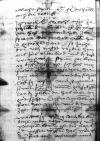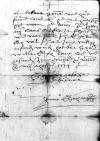Ich hab Ewer Gnade mer mallen, saÿd ich in ⌊Spanÿam⌋ komen peinn, geschriben und dona ⌊Iuanÿca⌋ halben meine maÿnong und gut bedoncken anzaiget, ouch daz selb montlich mÿt dem ⌊electus von Lunda⌋ geret. Daz ⌊thochterle⌋ facht an, gros werden, und yst zÿt, daz mans von der ⌊mutter⌋ neme. So mag Ewer Gnade die ⌊mutter⌋ mÿt 150 in 200 ducaten zu frÿden stellen uff ainn mal. Da mÿt wuÿrt ⌊sÿ⌋ irrn remedio suchen. So mocht daz ⌊tochterle⌋ Ewer Gnade etwa in geselschafft erlicher frowen und luÿt, so teglich ins ⌊Nÿderland⌋ faren, da hein gesant werden. Das rant ich Ewer Gnade als ainn trüewer, gutter gefather, dan es kan nÿt mindere seinn. Die kinder mussend gelt costen, das waÿs ich peÿ miere selbs. So man die arbaÿt nÿmpt, die zu machen, so mus man nach mals geduldt haben, den seckel uff ze thun. ⌊Albrecht⌋ ⌊⌋ Ewer Gnaden deshalben ouch die nottorfft.
Ich waÿs Ewer Gnade nÿchs nuÿes ze schriben. Der ⌊kaÿsser⌋ ÿst zu ⌊Palencz⌋, der hoff hern und her zer spraÿt, des sterbend halben, hie an gefangen hant. / So zuÿcht ⌊der von Nassov⌋ wÿder hein aus ins ⌊Nÿdereland⌋ und daz vast wenÿg tuÿsch, schiere gar kaÿner an dÿssen hoff ÿst. Ich hab mein ⌊frowen⌋, Ewer Gnade gefather, hie peÿ miere. Ire wil die selczamen loff in unsern landen regierend, so wil ich im namen goz in dÿssen landen pliben. Da hab wiere ainn gut, sÿcher, crÿstenlich leben. Got der her welle uns daz lange zÿt mÿt gnaden verlichen.
Wie das in unssern ⌊landen⌋ der krieg dorch ander nazion anrÿchten und platiquen komen ÿst, des mag Ewer Gnade pesser wÿssen. Haben wier wd aine fart ouch gestraufft, werden al bekant herren und gut fre und lond Ewer Gnade viel gutzs sagen. Pÿt Euwer Gnade immer zu zÿtten ainn clains brieffle ze schriben, und war innen ich Ewer Gnade dienen kan, wil ich al zeÿt willÿg erfonden werden. Got der her welle Ewer Gnade lang leben und gesunden zÿt verlichen.



